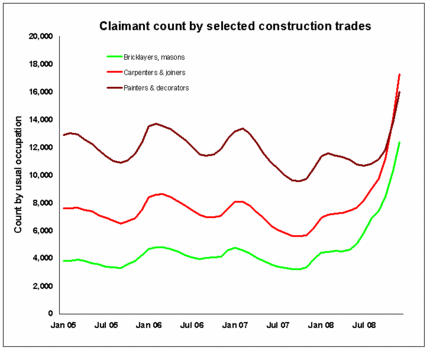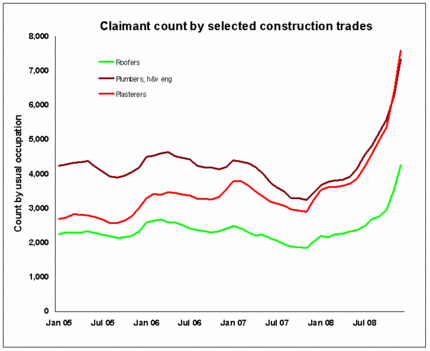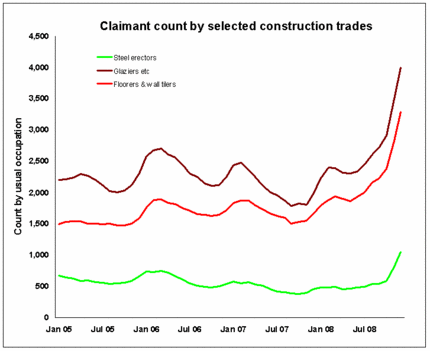Trades not professionals have been hit hardest by construction job losses
I read with interest the Sunday Times story about how quantity surveyors were joining the dole queue at a faster rate than any other group in the UK economy.
So I looked at the base figures and, well, came to a remarkably different interpretation.
Put it this way, if the Sunday Times’s interpretation was reasonable, I could with equal justification and would with some gusto be arguing in the pub that my mate who was finally supping down his second pint was drinking faster than me, as I swallowed my fifth.
Think about it. The second pint doubles the intake while the fifth pint is just an extra quarter.
Nonsense? Of course it is. And so is the idea that quantity surveyors are joining the dole queue faster than anyone else.
So what are the figures really telling us?
As always the first thing to say is that the claimant count figures can only tell us so much, because some people losing full-time work shift into part-time work, some take redundancy and start a freelance career and some people resist signing on because they think the next job is just around the corner.
So the claimant count figures are not a direct measure of job losses.
Looking at the dole queue figures for quantity surveyors what is interesting is not the rate of increase, but the fact that they stood at just 100 on the claimant count a year ago.
Yes the number of surveyors on the claimant count has increased proportionately faster than any other of the groupings within the data. But given that the number of claimants in December 2007 was 100 and that has grown to 590 against a population of between 50,000 and 60,000, we are not talking about the figures suggesting huge amounts of relative pain.
That is if we take the claimant count numbers as our measure of pain in the jobs market.
Perspective is what we need here. If you go back to the figures for 2006 there were 135 and in 2005 there were 170 on the claimant count. 100 was the best it ever got for quantity surveyors – it would seem they were in exceptional demand in December 2007.
The 100 figure suggests that about 1 in 600 people among quantity surveyors was on the claimant count. If that proportion applied across the whole population of jobseekers there would have been a total claimant count of about 50,000 at the end of 2007 instead of the 800,000 plus.
An extra 490 quantity surveyors on the claimant count is less than 1 in 100. This is not good, but if you want to see where the pain is being dished out look at the trades.
If you look at the bricklayer numbers you will see an extra 8,000 or so added to the claimant count over the year. Using the Sunday Times interpretation, that is a piffling increase of 191% against the whacking 490% growth in claimant quantity surveyors.
Let’s look at it another way. There are just shy of 90,000 bricklayers in the UK construction industry, according to the Construction Skills Network figures. That means that about an extra 1 in 11 has signed on, against fewer than 1 in 100 quantity surveyors.
It is the nature of the business that there will be a reserve of brickies signing on at any one time. Despite the relative boom years in 2005 and 2006 there were more than 4,000 brickies signing on. So inevitably the percentage increase will be held down, given the relatively high starting point.
Mind you for my money that 1 in 11 seems a bit light given the carnage in the house building sector. It may well hide other factors, such as the self-employed will be working less or many migrant brickies may have left for a more welcoming employment scene at home.
It is not just the brickies that are being hit hard, other trades are suffering. And if you slice the data by region you see the pain appears to be worse in some places than others. At first glance, the South West appears to have taken quite a knock.
Most of the quick analysis I have done here is based on pretty wobbly numbers in that I am comparing claimant count determinations of occupation with that in the Construction Skills Network analysis of jobs numbers in construction.
The idea is just to give a rough and ready indication of what is going on and I am broadly confident that we are in the right ball park.
Just so there is no confusion, I am not denying that things are getting hairy for the professions in construction, shockingly so in my view.
But I do think we need to look at the figures a bit more diligently (considerably more so than I have here) if we are to start making big claims such as quantity surveyors are being hardest hit in this downturn.
It is, for instance, quite easy (if you leave your training in research methods at the door) to argue a case that within quantity surveyors it is the young women that are being shed disproportionately. It may be true, it may not, but the numbers could be stacked to make the case.
Anyway just for your interest, here are some graph of some of the selected trades in construction and for selected professions.




Source: National Statistics (Nomis: www.nomisweb.co.uk)
Crown copyright material is reproduced with the permission of the Controller Office of Public Sector Information (OPSI).